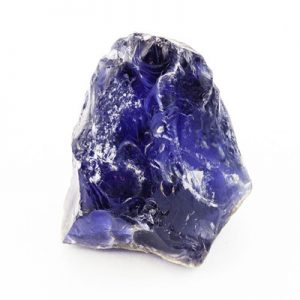Iolite (Cordierite)
Cordierite can be called Iolite, Dichroite or also “water sapphire” due to its sapphire that is frequent blue. Although Iolite may be the widely utilized title for this gem, Cordierite is the IMA recognized title for the mineral species. Iolite has intense and pleochroism that is distinct colors of blue, violet, smokey blue and grey when viewed from various angles. Iolite’s crystal structure is virtually identical to that of Beryl and is a known member of the Beryl series of minerals. Cordierite forms a primary solid solution series with the rare mineral Sekaninaite. Iolite is that the magnesium-rich finish member and Sekaninaite is that the iron-rich finish member.
Most iolite forms throughout regional metamorphism of shales and different clayey rocks. once shaped below these conditions, it’s found in metamorphic rock and gneiss. Less often, it forms throughout contact metamorphism and is found in hornstone. iolite is additionally found as an adjunct mineral in granitic igneous rocks and in pegmatites. once crystals of iolite have the chance to grow while not obstructions, they’ll type short prismatic crystals with an oblong cross-sectional.Pure iolite with none iron present isn’t common. Iolite rarely contains inclusions of hematite plates that create a schiller effect that is breathtaking.
Although Cordierite is found in many locations worldwide, relatively few create fine, gem-quality crystals. A few of the better-known sources of Iolite gems are Coroaci, Minas Gerais, Southeast area, Brazil; around Tiruchchirappalli and Coimbatore, Tamil Nadu, India; Tranomaro area, Amboasary Department, Tuléar Province, Madagascar; and from the gem gravels of Sri Lanka.
| Category: | Cyclosilicate |
| Chemical Formula: | Mg2Al4Si5O18 |
| Crystallography: | Orthorhombic – Dipyramidal |
| Crystal Habit: | Crystals short prismatic, striated, to 18 cm; typically granular to compact, massive. |
| Twinning: | Common, simple, lamellar, cyclical. |
| Cleavage: | [100] Imperfect/Fair, [001] Poor, [010] Poor |
| Fracture: | Conchoidal, Sub-Conchoidal |
| Tenacity: | Brittle |
| Hardness (Mohs): | 7.0 – 7.5 |
| Density: | 2.60 – 2.66 (g/cm3) |
| Luminescence: | None |
| Radioactivity: | Not Radioactive |
| Color: | Colorless, Pale blue, Violet, Yellow, Gray |
| Transparency: | Transparent to Translucent |
| Luster: | Vitreous (Glassy) |
| Refractive Index: | 1.527 – 1.578 Biaxial ( – ) |
| Birefringence: | 0.0110 – 0.0180 |
| Dispersion: | 0.017; Weak; r < v |
| Pleochroism: | Strong; X = pale yellow, green; Y = violet, blue-violet; Z = pale blue |


